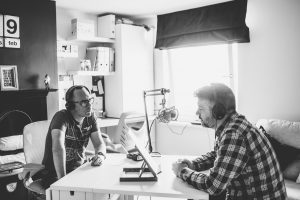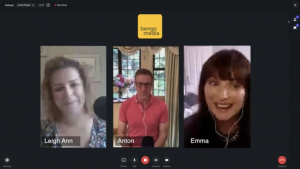How to Record Podcasts On Zoom? DON’T! 2 Better Ways To Try




Ah, remember lockdowns? They were… terrible. But one halfway good thing to come out of the lockdown periods was content – lots of content – made by budding amateurs who found their voices in podcasting.
The “let’s start a podcast!” trend was a lot of fun, at least from our perspective (even if everyone and their nan had started one by the end of lockdown number two). But it threw up a big problem, and one that persists up to today: how do you maintain a podcast over long distances, where people are separated by miles – or by oceans?
Zoom, the little video conferencing platform came to define a shared moment in global history. It gave us all a way to see each other when we couldn’t do so in person, helped businesses carry on working during the darkest times – and it even seemed perfect for recording and capturing podcasts.
Except, recording podcasts on Zoom (or Teams) is far from ideal. Sure – it’s easy, accessible, but the quality of podcasts recorded on video conferencing platforms is notably bad, even to non-audio people. It isn’t the best way to do it, and here’s why.
Zoom was made for a different kind of pro
Zoom was made for office-based professionals to connect with remote workers. As a result, prioritises ease of use, and the experience in the moment, over audio quality. Don’t forget, it’s doing video, too. And there has to be a compromise between quality and efficiency. Something’s got to give, and most of the time, audio does the giving.
The audio in Zoom is highly optimised for delivery over the Internet, meaning huge amounts of it are filtered out from the top and low ends of the frequency spectrum – which is why people’s voices can sound boxy and honky on Zoom.
This is audio file compression (which is different from using a compressor plugin or device, but that’s a conversation for another day), which is useful in the conferencing context – it helps your video chat flow more smoothly over variable Internet connections, because there’s less data to bounce around.


But when you play back the recorded audio, it is noticeably low quality, in a way that doesn’t strike you as much as when you’re actually recording – maybe because you can hear your own voice in your head, or in the room.There is ways around this by changing your audio settings but it’s fair to say that this can add a bit of time onto your recording session especially if your guests need a tech set up too!
Another downside to recording a Zoom podcast is that it takes place over a live Internet connection. Everyone needs a reliable connection to make it work, and without one, you get lots of comments like “oh sorry, you cut out there”, which can ruin the flow of a show, and takes a lot of post-production editing to fix.
Oh, and the 40-minute time limit on the free version makes recording that little bit more stressful than it should be, so you’ll need to pay for a subscription if you want to get in-depth with your guests.
One more thing: guests invited to record Zoom podcasts rarely have good sounding rooms, let alone professional audio equipment. You’re likely to get a boomy, echoey sound to their voice, and if they’re using AirPods or a wireless headset, the audio going in will be even more digitally compressed.
The result? Bad – listener unfriendly – recordings.
If you want to record a podcast in higher quality, Zoom will not get you there easily.
We’ll discuss a few ways you can make it better, but first, let’s talk through some better alternatives to recording podcasts on Zoom.
Top alternatives to recording podcasts on Zoom
Pre-recorded and remote studio options
One way to get amazing quality results is to have your guest record using the best possible option for them. They may have a plug in microphone or a set of headphones that have a microphone attached. These can be great for a first time recording with the advice of having any long hair pulled away from the mic and to avoid touching it or moving it about as much as possible. There are also an abundance of built in computer apps that make the recording process smoother. You can even use a good old voice memo application. This can be done with pre-recorded responses to questions, given by a remote interviewer, who is then edited out for the main host. If you have the budget and and the luxury or a studio you could even do the interview yourself over Zoom, but have the audio captured by an engineer in a studio, using their audio-treated space and equipment – then edit your recording into theirs.
These options are costlier, in both production and post, but they’ll get the best result if meeting your guest on-site is impossible.
Podcasting software
There are a ton of podcasting platforms out there right now, and about a million ways to record. Direct to your phone, with a recording interface plugged into a laptop, all the way up to recording in a full-blown production studio. Podcasting software and apps are ten a penny, with some offering remote recording capabilities.
The difference between these platforms and Zoom (or Google Meet, Teams et al) is that they are audio-first; your audio is recorded locally, and your guest will have the option to record locally, too. Here are just some of the options:
Riverside


Riverside might be the biggest name in remote podcasting apps – and for good reason. It records locally to each participant’s device, recording in up to 48kHz audio and 4K video. Choppy internet connections be damned, Riverside gets great results. It’s pricey for beginners though, at $19 per month on a rolling basis.
Squadcast


SquadCast serves as a reliable cloud recording studio, offering flexibility for capturing quality audio from various locations. The platform enables users to record audio locally or in the cloud, ensuring a comprehensive recording experience for remote sessions. Retrieving recordings is straightforward, with local audio available in WAV and MP3 formats. The platform has also teamed up with Descript and are offering high quality AI transcription based editing for everything that gets recorded…pretty cool!
Zencastr


Zencastr is a website-based app that can record lossless, CD-quality 16-bit WAV files – for each guest. Note that Zencastr records locally to the participants’ devices.
No choice but to Zoom?
If you absolutely, positively have to use Zoom or Google Meet, or any other conferencing platform – then try your best to get it right at the source.
If possible, send some basic hardware – a foolproof USB mic, and instructions on best practice (setting gain, using a quiet, audio-absorbent space and so on). We made some recommendations of good equipment in this post: Podcast Setup – 3 Person Podcast Recording Costs.
If you’re stuck with a built-in laptop mic, AirPods, and a bad room – there are a few post-production tricks that can make things a smidge better. Plugin suites now feature room-reduction tools; Apple computers have a native Audio Unit device for this, which can be used in Logic, Garage band, or any other AU-capable editor – such as DaVinci Resolve for video.
We can advise you on all of this in simple tutorial sessions or take the stress totally out of your hands and have the recordings up and ready to go so you can turn up as an interviewer or interviewee and feel at ease that the tricky tech part has been handled for you! phew!


Do you want to get your podcasts up to pro standard? Learn more about our podcast services. Get help with full podcast production, or just recording and editing – from our team of audio recording and production experts.
